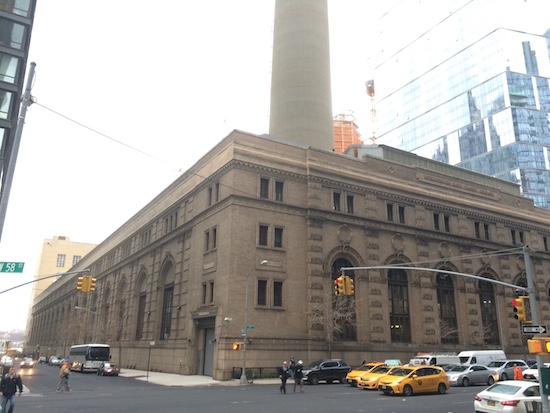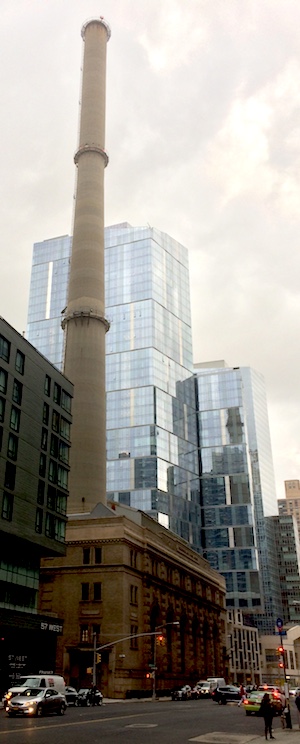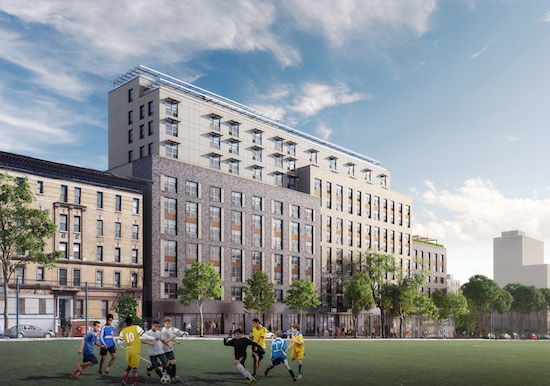Welcome to the Upper West Side, where even our powerhouses are historic!
A powerhouse designed by prominent architect Stanford White at the turn of the last century has won landmark designation after a fight that lasted almost 40 years. The former IRT Powerhouse on 11th Avenue between 58th and 59th Street, built between 1900 and 1904, won unanimous approval from the Landmarks Preservation Commission on Tuesday. The powerhouse, now owned by Con Edison, still generates electricity. The area surrounding it is now being built up fast, with the Riverside Center development bringing five new condos to a site just to the North (two are visible in the photo above).
 According to the LPC, it was “the largest powerhouse in the world upon its completion in 1904, and is considered the most monumental building associated with the subway system in New York City. The building continues to play a vital role in the city’s utility infrastructure as a steam and electric generating plant serving hundreds of Manhattan buildings including the Empire State Building and the United Nations.”
According to the LPC, it was “the largest powerhouse in the world upon its completion in 1904, and is considered the most monumental building associated with the subway system in New York City. The building continues to play a vital role in the city’s utility infrastructure as a steam and electric generating plant serving hundreds of Manhattan buildings including the Empire State Building and the United Nations.”
And it played a crucial part in the development of the subway.
“When the IRT Powerhouse was built, it heralded a new era of electrified urban transportation. William Barclay Parsons, chief engineer of the Rapid Transit Commission, decided to run the new subway system using electricity, which was in its infancy as a form of motive power. The subway needed a powerhouse of unprecedented size, with a waterfront location facilitating the delivery of immense amounts of coal and the removal of waste ash. Planned by a team of distinguished engineers including John Van Vleck and Lewis B. Stillwell, a leader in developing alternating-current systems for urban railways, the IRT Powerhouse represented the highest level of technical sophistication in the production of electrical power at the time. It was capable of producing 100,000 horsepower and holding more than 30 million pounds of coal, with coal delivery and ash removal largely automated through a system of conveyors and hopper cars.”
Local preservationists have been advocating since 1979 to turn this into a landmark, but have faced opposition. Con Edison told West Side Rag in 2011 that “a landmark designation would make it harder for us to operate and modify the station.” Some locals, however, were concerned that Con Ed would sell the site to a developer, who would then build a new development there. Con Ed sold a powerhouse on the East side to a developer a few years ago.
If Con Ed eventually stops using the powerhouse, some people have considered other uses for the building, with Vanity Fair publisher Graydon Carter even suggesting it could become a photo museum.
In 2014, the LPC considered taking the powerhouse off the list of sites being considered for designation, but decided against it.









Love this story!
That’s great news!
Thank you, Landmarks Preservation Commission!!!
Glad for the landmark designation, but
by what measure is 58th street the “Upper West Side”?
Great question, and I believe the answer is by virtue of our city council district. Map here:
https://pbnyc.org/content/district-6-map
excellent!
Just curious, how is the subway system powered now, if not by a dedicated facility? Just general Con Ed power, like any other customer?
Since about the 1950’s or thereabouts the NYC subway system receives power directly from the New York Power Authority. Hence the various “subway” power stations located around the city soon became surplus to requirements.
https://www.nycsubway.org/wiki/Subway_FAQ:_Facts_and_Figures
IIRC nearly all these subway power plants were built to burn coal (hence being located near East or North Rivers, where barges could bring in the vast amounts required. The air quality in surrounding neighborhoods must have been horrible.
Not exactly. Without going into the engineering technicalities, let’s just say that, when the train you’re on slooooooows down, or stops between stations without any explanation whatsoever, while you’re trying to get to to work or home or an appointment, that the hamster got tired.
Re: “…that the hamster got tired.”
GREAT POSTING!!!
Of course, to relieve the hamster, here are some other sources of power:
1) Bicyclists who run red lights in Manhattan, will, when caught, be forced to ride stationary bikes hooked to a power generator for the number of hours corresponding to the numbered street where their infraction occurred.
2) Turnstyle “jumpers” will generate power by jumping up and down upon a power-generating device. Again the number of hours spent jumping to be determined by the digits on the station where the infraction occurred.
Of course, a mathematician will have to devise a formula to apply to the “hip” types who never venture above 14th street and to ease the pain on people living above 96th street.
Great news; this building has been a favorite of mine forever and I am so glad it will remain so and not be replaced by a glass structure signifying nothing.
Hooray!
I love West Side Rag!
my personal feel good story: i just re-watched the obama ‘love and happiness’ end-of-reign white house special. i’d forgotten what it’s like to have a cultured leader. as it turns out for me, it’s important. a great feeling to listen to him, watch his reactions, and to see him dance.
i got a similar feeling from this story. a great feeling to read of a ‘victory’ for people who value (industrial) history and seek to retain certain references to the past.
This is such a tremendous victory for or neighborhood and the history of NYC. I recently asked my grandfather about this building at a family wedding.
My grandfather, William E. Caldwell Jr, now 96, spent most of his career managing a part of New York City’s power infrastructure for Con Ed. I asked him about this building several months ago at a family gathering.
I was struck at how visceral and vivid his memory and affection for the IRT Powerhouse was despite it being decades removed from his career, and his general lack of sentimentality for such things. He told me that it was a great thing that people were trying to preserve a bit of the history of how this city “grew up.”
Big thank you to the several decades efforts of those at Landmark West! Thank you for saving this gem for future generations who will be able to appreciate this bit of history for years to come.
Fun fact: did you know (you probably did) that the reasons the numbered and lettered train lines aren’t interchangeable is because the tunnels and cars are larger on the lettered trains. Once upon a time there were two warring subway companies: The Brooklyn Rapid Transit Company,(Lettered train lines) and the Interborough Rapid Transit Company (numbered train lines.)
The IRT company did not want the tunnels to be used for freight, so they dug their tunnels smaller and narrower. This is why the lettered subway line cars are larger than the numbered subway line cars.
We used to build great things in this country…
The Beaux Arts movement gave us architecture that was not only functional, but turned even ordinary manufacturing or industrial buildings into works of art.
Pennsylvania Station, Grand Central Terminal, and many other examples not just in NYC but all over the USA were a direct result of this European influence.
Sadly BA didn’t last very long (from 1860’s to 1920’s give or take), and no small amount that was built in USA has been either demolished or left to rot and ruin.
https://en.wikipedia.org/wiki/Beaux-Arts_architecture#United_States
https://untappedcities.com/2012/04/11/new-yorks-temple-of-power-the-59th-street-powerstation/
It was the Brooklyn-Manhattan Transit Company, or BMT.
Not as simple as you say. There was also the Independent subway, known as the IND. It was the last of the three.
Thanks for sharing that info..didn’t know the cars were different sizes.
That also explains why the IRT was the last line to be air conditioned. The tunnels were such a close fit for the cars that there was no room to put an air conditioning unit outside the cars, as had been done on the larger BMT and IND lines (which had even larger tunnels).
Eventually the Transit Authority retrofitted cars with air conditioning units *inside* the cars. This is why the ceilings in IRT cars, even on the newer ones, are so low.
The building inevitably would have been sold and demolished. The facts about Con Edison’s steam
generation are that it has long been obsolete as the most expensive and inefficient heating source in NYC,
replaced by Con Ed gas or co-generation building systems. Con Ed uses a small portion of the space at the western end of the building to service its diminishing customer base. Many other
public uses have been suggested, in addition to Conde Nast.s photo collection . Now these can be considered.
Con Edison has not signed up a new steam customer in decades IIRC.
Worse their current customer steam heat/AC base is shrinking as buildings find more cost and energy efficient means of heating and cooling besides centralized steam.
https://cooperator.com/article/steam-to-boiler-plant-project-pays-off-for-ki/full
One of the main issues with any central steam heating system is the limitations of how far you can send steam. Hot water OTOH can go further than steam and is used extensively around the world for central distribution.
Con Edison’s steam system only runs to 96th Street, IIRC. That means Columbia Presbyterian Hospital unlike those located further down town had to make other arrangements for steam. For the record hospitals use steam not just for heating/cooling, but to supply autoclaves and sterilizers.
https://www.gothamgazette.com/index.php/government/2104-steam
That powerhouse is a beautiful monster.
Sometimes I stand across the street and gawk at it. I’m glad it’s being landmarked.
I lived in the building behind it and it is amazing! So glad it will be preserved.
Maybe Raymond Scott was thinking of this one when he wrote POWERHOUSE!
https://www.youtube.com/watch?v=HdDpiBcYta0
So when will the 100 story tower be built into the powerhouse?
Oh, Jim… I hope you’re wrong.
Do you think the smoke stack is excluded from landmark designation?
There were originally six smokestacks IIRC, but over the years all but the last remaining were torn down.
One imagines if the remaining smokestack became unstable or whatever *and* Con Ed could prove repairs were too costly, it could come down as well. Especially if the plant is decommissioned totally.
I had the same thought. Look what happened to the Hearst building.
Hearst building was never originally completed.
William Randolph Hearst seemed to lose interest in the project, and then came the Great Depression which pretty much ground many major construction projects in NYC to a halt.
https://www.nytimes.com/2005/09/18/nyregion/an-urban-landmark-in-manhattan-grows-by-46-stories.html
It’s an impressive building from an architectural standpoint but it’s grimy and dreary.
It would be great the building was cleaned up and sandblasted.
Furthermore, I’ve read (and another commentator noted) this is a huge building much of it is not in use. This seems to be a waste of space. This space should be converted to something more productive for the area.
“This space should be converted to something more productive for the area.”
Right! Let’s get some more luxury condos built for the foreign oligarchs. Can never have enough of those, can we?
And, hey, you can still see the sun sometimes in this area — we can’t have that. Tear it down, and build ’em high!
Sheesh.
I never said tear it down. I said keep the building but utilize the space accordingly.
You’re a shmuck and don’t attack me for things I never said!
nice win
Just to be clear, fears about decommissioning and selling off this property are not totally unfounded.
Remember Con Edison is an investor owned entity, and thanks to changes in NYS laws has been forced to sell off/divorce itself from power generation and supply.
Just as with Con Edison’s extensive former holdings on the East River in Turtle Bay, they could sell off that waterside West 58th Street property for *very* big money.
https://nypost.com/2000/11/29/con-ed-waterside-sale-signs-deal-to-turn-over-power-plant-site-near-u-n/
https://www.nytimes.com/2013/08/04/realestate/high-rises-to-replace-an-east-side-eyesore.html
Difference today is you have a *VERY* active liberal and progressive mayor and city council that likely would either attempt to either thwart such a sale, and or force Con Edison to “give” something back. That and or use the city’s considerable juice in control of zoning to extract near painful concessions from any developer
However make no mistake, in this current over heated Manhattan real estate market that large parcel of land that comes unencumbered with (residential) tenants is worth plenty.
It is so surrounded by high rise buildings that you can barely see it. Such a beautiful building. I’m very glad Con Edison owns it because, having a personal interest they respect and care for this City.
“According to details provided on The Hudson River Powerhouse web site, Consolidated Edison has contributed to the deterioration of the IRT Powerhouse: the company has “cut holes in the exterior walls, demolished the cornice and smokestacks, and punched out windows.” If the structure were to be designated a landmark Consolidated Edison would be required to maintain and preserve the IRT Powerhouse, without altering the façade and structure of the building, “for generations to come.” The investor-owned company would also be expected to reduce its existing footprint substantially within the building and/or move its operations to a more sustainable location.”
https://untappedcities.com/2012/04/11/new-yorks-temple-of-power-the-59th-street-powerstation/
“Con Ed opposed designation. Con Ed senior architect Michael Corcoran argued that the building is not architecturally significant, emphasizing its lack of original fabric, particularly the chimneys and cornice. He also claimed that Stanford White only served as a consultant on the structure’s design and had little impact on the finished building. The powerhouse’s plant manager testified that the building was critical to Con Ed’s steam system. He said the facility needed to continue unencumbered, and expressed concerns that landmarking would prove burdensome and expensive.”
https://www.citylandnyc.org/con-ed-opposes-designating-west-side-powerhouse/#more-4888
Keep in mind since changes to city’s landmark laws earlier this year property owners gained significant leverage over properties being given that status against their will. We do not know what “agreement” was reached between the LPC and Con Edison, but assume it is spelled out somewhere.
Just to be clear, landmark designation of a structure does *NOT* mean it will ever escape redevelopment or demolition.
If or when Con Edison ever totally decommissions this plant, then things will become interesting.